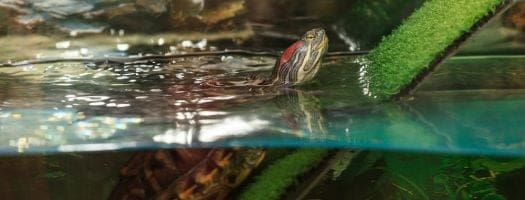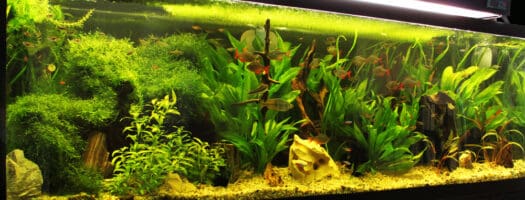The 10 Best Aquarium Filters to Keep Your Tank Clean in 2026
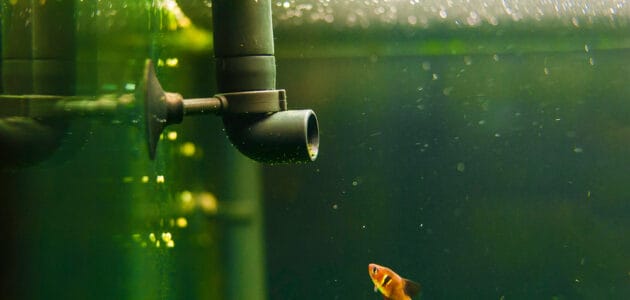
As a fishkeeper, you should know the importance of creating the perfect environment for your aquarium. Filtration doesn’t only make your tank clean and sparkly. It also helps keep your aquatic pets healthy. It removes waste, decay, and even invisible chemicals that could be potentially harmful to your tank’s inhabitants.
In other words, aquarium filtration is not just something that would be nice to have–it’s absolutely essential.
Many beginner tank owners often find it difficult to search for the right filter for their setup. Luckily, we’re here for you. This article contains everything you need to know about aquarium filtration as well as our picks for the best aquarium filters, factors to consider before buying, and everything else you need to determine which aquarium filtration system is most suitable for your setup.
- Factors to Consider When Shopping for Aquarium Filters
- Top 10 Best Aquarium Filters 2026
- 1. Best Overall Filter: MarineLand Penguin 350 BIO-Wheel Power Filter
- 2. Best Premium Pick: AquaClear HOB Fish Tank Filter
- 3. Best Budget Pick: Tetra Whisper EX Silent Multi-Stage Power Filter
- 4. Best for Small Tanks: Fluval U4 Underwater Filter
- 5. Most Quiet: Aqueon Quietflow E Internal Power Filter
- 6. Best for Large Tanks: MarineLand Magniflow Canister Filter
- 7. Best Sponge Filter: Lefunpets Biochemical Sponge Filter
- 8. Best Basic Filter: Penn-Plax Small World Aquarium Filter
- 9. Best Undergravel Filter: Penn Plax Premium Under Gravel Filter System
- 10. Best Canister Filter: Fluval FX6 Canister Filter
- Complete Buyer’s Guide to Aquarium Filters
- Final Thoughts
Factors to Consider When Shopping for Aquarium Filters
Before you go and buy aquarium filters for your tank, let’s first talk about the most critical factors you need to consider in an aquarium filter.
Kind
Filters come in many different kinds, from the basic sponge filter to the more variable internal canister-type filter. For instance, you’ve got power filters, hang-on-back (HOB) filters, undergravel filters, and fluidized bed filters.
Each one has its own features, benefits, and even styles that will suit different types of tanks. If this is your first time hearing about this topic, don’t worry because we’ll discuss all the finer details further below.
Wattage
Your filtration system is typically the only aspect of your aquarium that will be operational 24/7, so wattage is a significant consideration when choosing which product to buy. Remember, the larger the filtration and the more volume it can circulate, the higher the power consumption.
Recommended Capacity
This factor is measured in flow rate, which is the amount of water that the filter can circulate through itself in an hour. This will be discussed further in its specific section below.
The higher your bioload is, the higher your chosen capacity should be. After all, your filter must be able to service your system appropriately.
If your filter is too strong for your aquarium, it will disturb the substrate and even rip your plants apart, causing stress to your animals. Too little, and it won’t be able to filter out all the harmful stuff in your tank. Evidently, installing a filter with the wrong capacity can harm your aquarium.
Media
This refers to the material that does the filtration within the filter system. The water passes through the media, coming out clean and biologically safe on the other end. There are vast filter media choices out there, from filter floss to bio balls and even more exotic options such as lava rock and specialized fluidized media.
When determining the media you want in your filter, keep in mind the type of filtration that it covers, which we’ll also discuss further below. Ideally, a single filter product should be able to provide at least biological and mechanical filtration. Some products also include chemical filtration.
Noise Level
Lastly, flowing water can be quite noisy. Filters themselves are powerful little motors designed to handle heavy loads, so you can probably imagine how loud they can get.
If your aquarium is located somewhere that you don’t spend a lot of time in, then this factor may not be as important to you. However, if your aquarium is located in your bedroom, then you should consider going for the noiseless options as the unit is going to be running 24/7.
With these factors out of the way, let’s now get into our list of the best aquarium filters you can buy online right now! If you still need more aquarium accessories after finding your filter, we encourage you to check out our list of the best pH meters and heaters for your aquarium.
Top 10 Best Aquarium Filters 2026
1. Best Overall Filter: MarineLand Penguin 350 BIO-Wheel Power Filter
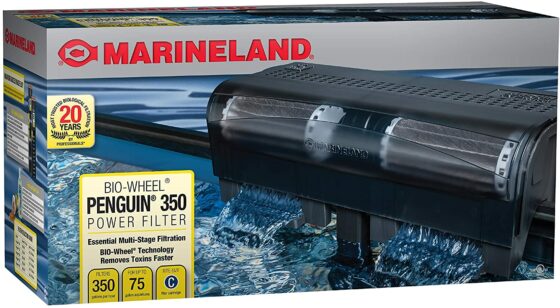
Editor’s Rating:
Why we like it: The MarineLand Penguin Power Filter gives the beneficial bacteria in your tank a much-needed boost with its Bio-Wheel technology, on top of its 3-stage filtration, reliable design, and adjustable flow rate features.
Quick Facts
- Style: HOB
- Wattage: N/A
- Capacity: 20 gal / 30 gal / 50 gal / 70 gal
- Flow Rate: 75 GPH, 100 GPH, 150 GPH, 200 GPH and 350 GPH sizes
The MarineLand HOB Filter may be priced at a premium, but it’s undoubtedly one of the best ones around.
It boasts a three-stage filtration system that removes debris, unwanted particles, impurities, discoloration, and foul odors in the aquarium. Up to 4 different sizes are offered to suit all kinds of tank dimensions. Replacement parts are also very easy to come by. It also has an adjustable flow rate to suit different aquarium environments. Functionally, its design doesn’t allow water to skip the chambers, ensuring proper filtration.
A signature feature of the MarineLand brand is its patented Bio-Wheel technology, a more efficient way of biological filtration than traditional porous media. It uses specially designed material to maximize surface area and a rotating wheel to oxygenize the beneficial colony.
However, the ever-spinning Bio-Wheel feature produces a lot of noise, creating a gurgling waterfall sound effect. It also makes splashes more often than traditional filters, so you have to prepare accordingly. Lastly, if your tank has custom dimensions or is rimless, this filter would be quite hard to install.
Pros
- Thorough filtration
- Boosted biological filtration with Bio-Wheel technology
- Adjustable flow rate
- Easy to find replacement parts
Cons
- Makes a lot of noise and splashes
- Hard to install on customized or rimless tanks
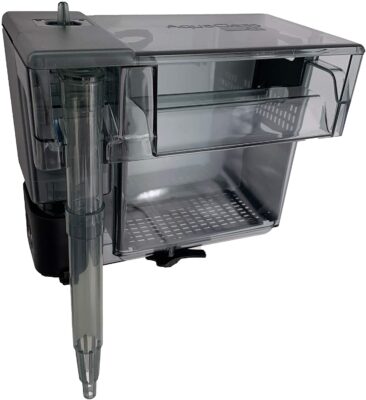
Editor’s Rating:
Why we like it: If you want quality in its most crystal-clear form, what you’re looking for is the noiseless, three-stage, adjustable, and energy-efficient AquaClear Hang on Back aquarium filter.
Quick Facts
- Style: HOB
- Wattage: N/A
- Capacity: 5 to 20 Gal / 10 to 30 Gal / 20 to 50 Gal / 40 to 70 Gal / 60 to 110 Gal
If you’re looking for the best balance between performance, durability, and noise level in your aquarium filter, then the Aqua Clear Filter should be at the top of your list.
Instead of bio-wheels that splash around and create all sorts of noises, it contains ceramic rings. As a result, it’s one of the quietest filter options out there. It even has multiple size options for different aquarium sizes.
It offers three-stage filtration, complete with mechanical, biological, and chemical media to filter out unwanted particles in your tank. The flow rate is also adjustable, perfect for delicate fishes and small tanks. Plus, due to this product’s re-filtration technology, there’s a lot of turnover in the aquarium, even if you choose a lesser flow rate. It’s also more energy-efficient than other brands, allowing you to save money on operating costs.
However, be wary if you use sand as your tank’s substrate, as the suction flow may be too strong. Remember, the impeller in your unit could get ruined if sand gets into it.
Pros
- Very minimal noise
- Thorough, three-stage filtration
- Adjustable flow rate
- Re-filtration technology
- Energy-efficient
Cons
- Suction may be too strong
3. Best Budget Pick: Tetra Whisper EX Silent Multi-Stage Power Filter
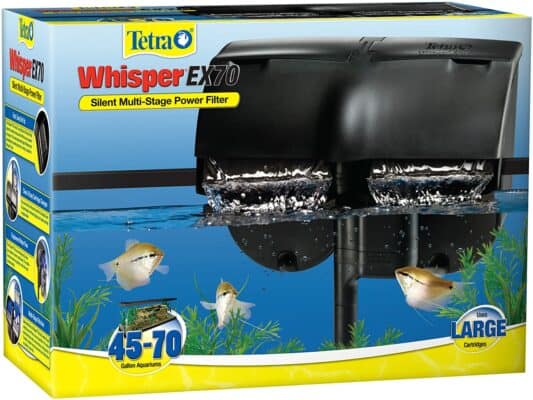
Editor’s Rating:
Why we like it: Tetra’s Whisper EX power filter may not be as feature-packed as other brands on this list, but its solid performance and reliable design have allowed it to stay on many aquarists’ good side for a long time.
Quick Facts
- Style: HOB
- Wattage: 8W for EX30 / 10.5W for EX70
- Capacity: 10-20 Gallons / 20-30 Gallon / 30-45 Gallons / 45-70 Gallons
- Flow Rate: 110 GPH / 160 GPH / 240 GPH / 340 GPH
Although the Tetra Whisper EX lacks many things that other brands have, its reliability and durability are good enough reasons to give it a try. Despite the low price, it lasts just as long and performs just as well, making it our best budget pick on this list.
The open-media design of the filter box allows you to customize it with any replacement filter media of your choice. It offers an adjustable flow rate that is effective at keeping your tank crystal clear. The unit requires very little maintenance and is almost truly set-it-and-forget-it.
It’s not as quiet as the more expensive brands with specialized designs, but the noise is not unreasonable either. Another issue is the quality of the filter medium that comes with the box. It’s easy to replace, though. Ultimately, while there’s not much with the Tetra Whisper EX in terms of features, unlike more pricey options like the MarineLand HOB filter or the AquaClear HOB filter, what it can do, it does well enough.
Pros
- More affordable than the competition
- Minimal maintenance required
- Durable and lasts a long time
- Solid, reliable operation
Cons
- Boxed filter medium is inadequate
- Not as quiet as more expensive brands
4. Best for Small Tanks: Fluval U4 Underwater Filter
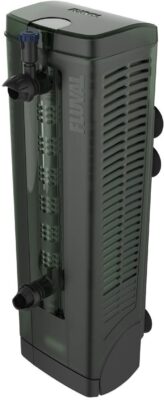
Editor’s Rating:
Why we like it: The Fluval U4 can give your freshwater, saltwater, or reptile aquarium top-quality filtration thanks to its 3-stage filter and BioMax technology.
Quick Facts
- Style: Internal canister filter
- Wattage: 5W for U2 / 5W for U1 / 6W for U3 / 12W for U4
- Capacity: 12 to 30 US Gal / 15 Gal / 24 to 40 US Gal / 34 to 65 US Gal
The Fluval U4 Underwater Filter features easy assembly, installation, and maintenance. The filter media inside can be easily accessed through the unit’s flip-top lid, allowing you to service and maintain them easily. It’s also ideal for a wide variety of aquarium sizes, from 12-65 gallons. It also comes with its unique BioMax biological media technology that efficiently houses beneficial bacteria.
Since it’s an internal filter, it provides filtration without taking up space outside of your aquarium, nor does it make a lot of noise during use. Plus, its nondescript black design doesn’t distract from the aesthetics of your aquarium.
It offers 3-way control of flow, namely Bottom Output, Integrated Spray Bar, and Top Output. The bottom output option allows for deepwater, lower-level agitation of your tank. The integrated spray bar option emits an even, gentle flow, while the top output option allows for oxygenation and water circulation.
However, there’s a gap between the suction cup and the filter itself that could be dangerous should your pets wander in there. Due to the suction strength and the limited area to move in, your fish could get stuck, leading to death if unnoticed. Also, despite the 3-way control, the flow rate is non-adjustable.
Pros
- Easy setup and installation
- Minimal noise
- Efficient filtration
- BioMax technology for biological filtration
Cons
- Non-adjustable flow rate
- Potentially dangerous design failure
5. Most Quiet: Aqueon Quietflow E Internal Power Filter
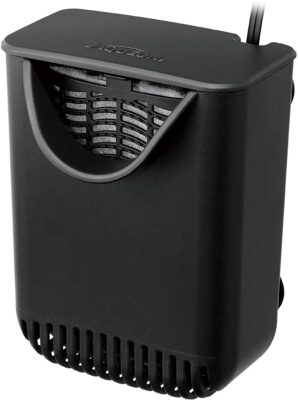
Editor’s Rating:
Why we like it: The Aqueon Quietflow power filter is a reliable little internal canister filter that is efficient, easy to install, practically noiseless, and can cater to a wide variety of filtration needs.
Quick Facts
- Style: Internal canister filter
- Wattage: N/A
- Capacity: Extra Small (3 Gal) / Small (10 Gal) / Medium (20 Gal) / Large (40 Gal)
- Flow Rate: 25 GPH / 60 GPH / 130 GPH / 290 GPH
Aqueon’s Quietflow power filter sports an economical design that can filter your water efficiently in three complete stages. It’s offered in 4 different sizes and capacities to cater to different tank volumes.
Beginner aquarists will be glad to know that this filter is very easy to install, regardless if you choose to install it via suction cups or hanging clips. The pump also doesn’t require priming for automatic installation or in cases of power interruption. True to its name, the Quietflow can stay quiet at all times, even if you push it to its limits.
Unfortunately, the non-adjustable flow rate makes it difficult to use in small aquariums or those that house delicate species. Maintenance and filter media replacement may also be more difficult for such tanks. If you have a small tank and would still like to use this filter, make sure to get the correct size to minimize the flow rate issue. That said, we recommend just skipping this altogether and using the Fluval U4 Underwater Filter or the Penn-Plax Small World Filter instead.
Pros
- Easy installation
- Three-stage filtration
- Minimal noise produced
Cons
- Maintenance difficult for smaller
- Non-adjustable flow rate
6. Best for Large Tanks: MarineLand Magniflow Canister Filter

Editor’s Rating:
Why we like it: With its strong flow rate, wide media capacity, and reliable filtration, Marineland’s Magniflow Canister Filter is genuinely heavy-duty equipment for heavy-duty tanks.
Quick Facts
- Style: External canister filter
- Wattage: N/A
- Capacity: Up to 30-Gallons / Up to 55-Gallons / Up to 100-Gallons
- Flow Rate: 220 GPH / 360 GPH / 360 GPH
Designed with heavy use in mind, the Magniflow Canister filter can comfortably cater up to a 100-gallon aquarium. It has one of the largest media capacities among all other heavy-duty external canister filters in the market. Each box contains a mixture of filter floss, foam, carbon, bio-balls, and ceramic rings, as well as four filter trays that allow for great flexibility in your media choices, should you decide to replace the options that come in the box.
The Magniflow also features a Quick Prime option that automatically starts the filter once everything is set up. Leaks are prevented through sturdy, sizable locking clams for the canister and motor. It has built-in handles in the motor head and media baskets for hassle-free disassembly during maintenance.
The design of the flow dish also makes sure that the water will pass through the filter medium for thorough filtration. Lastly, it boasts a 3-year warranty period, inspiring confidence in the product’s quality.
However, take care when handling the rubber gaskets of the unit, as they are quite fragile and can easily get lost. In addition to this, although the filter media that comes in the box is sufficient for beginner aquarists, more experienced tank keepers may find it inadequate for their tank’s filtration needs. The unit itself also consumes a lot of space, so make sure to plan accordingly before purchasing.
Pros
- Strong and robust flow rate
- Multiple filter trays allow for flexibility in filter media
- Very large media capacity
- Easy set-up and installation
- Sturdy, leak-free build
Cons
- Filter media can be improved
- Fragile rubber gaskets
- Takes up a lot of space
7. Best Sponge Filter: Lefunpets Biochemical Sponge Filter
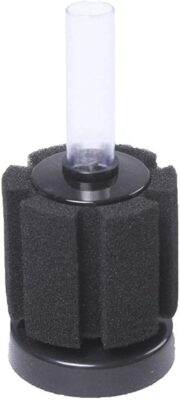
Editor’s Rating:
Why we like it: The Lefunpets Sponge Filter is a no-hassle, robust, air-operated filter that provides not only mechanical and biological filtration but also water aeration and circulation comparable to powerhead filters.
Quick Facts
- Style: Sponge filter
- Wattage: Depends on the aerator unit
- Capacity: Small (5-10 Gal) / Medium (1-10 Gal) / Large (10-25 Gal) / X-Large (30-80 Gal)
Lefunpets’ Sponge Filter is a solid choice for tanks needing gentle, undemanding filtration. Air-operated, the unit is connected to an external aerator via an airline. The air that comes from the aerator machine drives the water through the filtration sponge, so the rate of filtration will be based on the strength of your aerator unit.
The unit provides gentle, noiseless filtration that doesn’t endanger your fishes, shrimps, or plants and even oxygenates the entire tank. It’s easy to install, easy to disassemble, and easy to clean. The 4.5-inch sponge filter material does an excellent job of filtering most unwanted particles and even provides a suitable environment for beneficial bacteria to grow. It can also cater to 4 sizes of aquariums, from small to large.
That said, the product is a bit on the light side, making it relatively harder to attach securely to the tank. And like many other sponge filters, it also can’t handle heavy filtration demand in crowded aquariums.
Pros
- Quiet operation
- Ease of maintenance
- Simple installation
- Pet-safe
Cons
- Hard to secure in tank
- Weak filtration
8. Best Basic Filter: Penn-Plax Small World Aquarium Filter
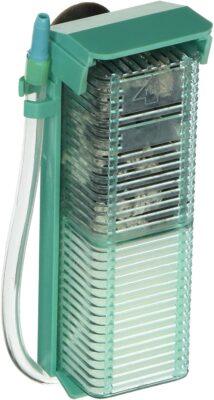
Editor’s Rating:
Why we like it: The Small World filter is a good choice for tank keepers on a budget, affording you three-stage filtration for the price of one sponge filter.
Quick Facts
- Style: Airpump operated internal canister filter
- Wattage: Depends on the aerator unit
- Capacity: 5 Gallons
The Penn-Plax Small World Filter is a nifty little aquarium filter that packs plenty of features into its small, oddly designed frame. The canister does not only contain a sponge filter but also carbon and ceramic media, giving your water a complete three-stage filtration, including water oxygenation. It’s air-operated, so the flow rate depends on the strength of the airflow.
Specially designed for small aquariums, this filter has a gentle output, which is ideal for fragile creatures like snails, shrimps, fry, and even bettas. The filter is compatible with any aquarium shape, as you only have to stick it inside the aquarium with the attached suction cups.
However, there are three main issues with this product. One, the build is quite fragile and cheap, even for the price. Two, there aren’t many size options. And three, the cartridge is non-replaceable, which means that you’ll need to replace the entire cartridge every time you need to do maintenance. This could cost you a lot of money in the long run. If you’re willing to spend a bit more on your small tank’s filter, you should take a look at the Fluval U4.
Pros
- Ideal for small setups
- Very inexpensive
- Three-stage filtration
- Safe for fragile pets
Cons
- Low-quality build
- Non-replaceable cartridge
- Few size options
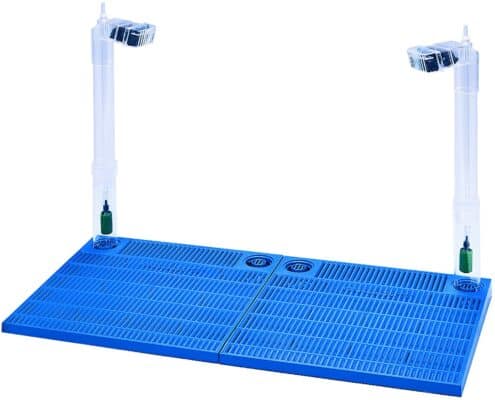
Editor’s Rating:
Why we like it: Undergravel aquarium filters were once hailed as the ideal starter pack for a novice aquarist – and the Penn Plax Under Gravel Filter System is a good example of why.
Quick Facts
- Style: Undergravel filter
- Wattage: Depends on the aerator unit
- Capacity: 40 – 50 Gal
One of the strengths of undergravel filters is that unlike clunky, space-consuming, and attention-grabbing filters, they don’t detract from the aesthetics of your aquarium. Penn Plax’s undergravel system is no exception.
It has two transparent outflow tubes that can be tucked away neatly into the corners of your tank, allowing maximum attention to your beautiful aquarium. As long as your tank’s bioload remains undemanding, this filter will not only keep your fishes healthy but also provide lots of water circulation and eliminate dead zones for your plants.
The system has four filter plates that are held securely by clips. Each filter outflow has a carbon medium for the removal of odors and harmful chemicals in your water. Setup is also very easy. Simply fit the undergravel filter to your aquarium’s floor area before covering it with the substrate. Afterward, all you need to do is hook it to an air pump.
However, undergravel filters, in general, are limited in their filtration capacities. If you have an overcrowded tank or fishes that excrete a lot of waste, we recommend choosing a different unit instead, like the MarineLand Bio-Wheel Power Filter.
Pros
- Two-stage filtration
- Eliminates dead zones in the tank
- Easy installation
- Minimal maintenance required
- Not distracting to the eyes
Cons
- Low filtration power
10. Best Canister Filter: Fluval FX6 Canister Filter
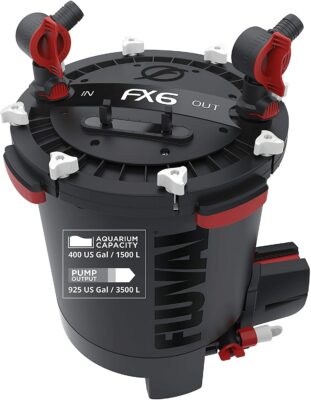
Editor’s Rating:
Why we like it: With a monster flow rate, stackable filter baskets, and rubberized feet, the hulking mass of the Fluval FX 6 is ideal for demanding, overcrowded, or oversized tanks.
Quick Facts
- Style: Internal canister filter
- Wattage: 43W
- Capacity: 400 Gal
- Flow Rate: 925 GPH
The Fluval FX6 Canister Filter is merely 21 inches tall, but the flow rate that it provides is no small thing. Ideal for 400 gallons, this powerful monster’s motors are capable of churning 925 gallons of water per hour – one of the highest flow rates among its competitors – making maintenance on your monster tanks a cinch.
In addition to this, its compact design filled with six removable filter baskets that you can stack means you’re afforded a wide range of options that is hard to match. The six stages of filtration are entirely customizable and the filter media included in the box can be easily replaced with your preferred media. The unit is self-starting and has easy water changing features and rubberized feet to ensure a silent operation. It also has a compact design that allows it to be hidden away easily so that it won’t distract from the view of your aquarium.
Unfortunately, beginners will find this unit very complicated to set up and maintain. Maintenance costs are obviously exorbitant as well, limiting who can use the unit and placing it in the last spot on this list. Also, its design can lead to a small downside. Since the unit can be cleverly hidden from sight, damages could easily go unnoticed until it’s too late.
Pros
- Powerful flow rate
- Six layers of filtration
- Silent operation
- Compact and easily hidden
- Sturdy and durable
Cons
- More expensive than the competition
- Difficult to set up and maintain
- Damages may go unnoticed until too late
Complete Buyer’s Guide to Aquarium Filters
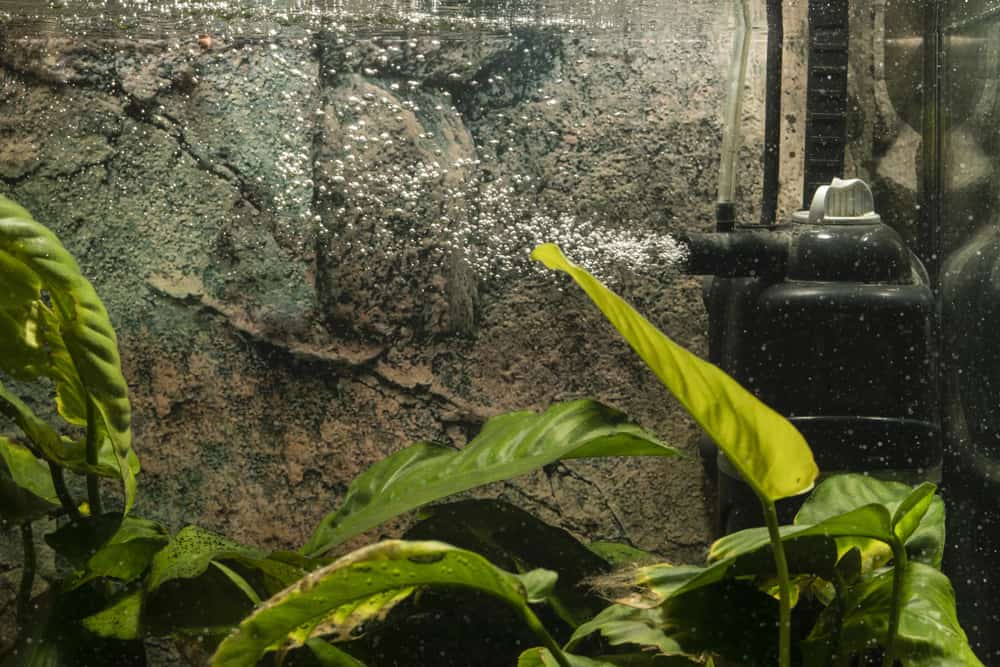
Nature works as a vast system complete with its own methods for mechanical, biological, and even chemical filtration. This is how flora and fauna thrive in their respective environments on the surface of the Earth. Lakes, for instance, where fishes, waterborne critters, and aquatic plants live, have their processes so that the ecosystem remains balanced and life-sustaining.
Of course, compared to lakes and oceans, aquariums are infinitesimally smaller in scale. But if you want a thriving and healthy aquarium, then it’s crucial to simulate what happens in nature within our little water-boxes. That is to say; water filtration is an absolute must.
Introduction to Aquarium Filters
Aquarium filters fulfill a lot of different roles in the aquarium. They keep the water running, distributing oxygen, nutrients, and chemicals to various parts of the tank. They provide a current for fishes and other animals to enjoy. Filters even keep the water clear so that your tank remains beautiful and sparkling for you to appreciate.
However, the primary role of an aquarium filter is to keep the water as clean as it can be at all times. And it’s not just for aesthetics. Clean water ensures that the environment remains livable for all your aquatic plants and animals. Remember, your fishes depend on their environment to stay alive.
Filters accomplish this by simulating the nitrogen cycle. Decaying organic matter turns into nitrite, a naturally occurring chemical compound that is toxic to animals in large quantities. In nature, there is an abundance of bacteria that feeds on nitrite and turns it into nitrates, which are less toxic but still poisonous in heavy concentrations. However, in ponds, lakes, and oceans, plant life breaks down these nitrates into something else that is harmless for the animals around — an interesting cycle that explains how nature keeps the balance.
Of course, this doesn’t happen spontaneously in your little aquarium. You have to do it by design — hence, your aquarium filter. Again, not only does it remove ugly chunks of matter, but it also carries out the nitrogen cycle so that your plants and animals can remain safe and healthy.
Benefits of Using an Aquarium Filter
- Keeps the water clean. One of the most noticeable benefits of an aquarium filter is that it keeps the water crystal clear in your tank, improving your aquarium’s aesthetics and allowing you to appreciate your underwater kingdom in all its glory.
- Makes the nitrogen cycle possible. Your filters also carry out the nitrogen cycle, which breaks down harmful chemicals into harmless ones so that they don’t adversely affect your fish and plants.
- Fosters a healthy environment. If your flora and fauna are healthy in your aquarium, you’re less likely to encounter problems that can cost you both time and money.
- Creates water movement. Filters also create currents in your otherwise stagnant aquarium water. These currents distribute oxygen, nutrients, and beneficial chemicals to all parts of your tank. Some fish species also enjoy water movement since it simulates their natural habitat, such as flowing bodies of water.
- Introduces other chemicals into the system. Plant fertilizer, medicine, and nutrients can be poured directly into your tank, and you can trust that your filter will distribute it evenly throughout the entire tank.
Important Features of Aquarium Filters
Every aquarium setup is going to have different needs, and every hobbyist is going to have different preferences. This combination of factors is what makes aquarium filters so varied and customizable. With all the options you currently have on the market, it may be challenging to determine what fits you best.
In this section, we’ll highlight the important features that you should look for in aquarium filters.
Volume and Occupants of Your Aquarium
The volume and the kind of living things that you keep in your aquarium are of prime consideration when choosing the best aquarium filtration product for your needs. This is because both factors directly impact your filter’s primary concern – water.
Simply put, the larger the volume, the stronger the filtration should be. The same goes for the amount of waste that your occupants emit. The more they excrete wastes, the harder your filter works. Thus, these two should go hand in hand for your consideration.
For example, small aquariums with undemanding occupants like plants, shrimps, or Bettas can get away with cheap, low-powered undergravel or sponge filters. Low-capacity internal canisters or submersible filters are also a good choice, as they provide better mechanical filtration than both sponge and undergravel filters.
For aquariums 20 gallons and up with more demanding fishes, like goldfishes, livebearers, or advanced species that require crystal clear water, you should choose hang-on-back systems or larger internal canister filters that could easily handle the load.
Flow Rate
The flow rate is the amount of water that the filter unit can cycle in one hour. This is usually measured in GPH, or gallons per hour. Flow rate is significant because it has direct effects on your aquarium setup. Too much flow can stress your fish and uproot delicate plants, too little can allow harmful chemicals to build up.
A good rule of thumb is to buy a filter unit that can cycle your entire tank 2 to 4 times per hour. To get this, simply multiply the gallons of your tank by the number of desired cycles. For example, the ideal flow rate for a 10-gallon tank is 20-40 GPH, while the ideal flow rate for a 30-gallon tank is 60-120 GPH.
Brand and Build Quality
You also need to consider the brand and build quality. Cheap filters with off-brand parts can sometimes cost you more money in the long run, especially if they malfunction too soon or too many times. A replacement part from an off-brand product could take weeks to arrive, perhaps even causing your fishes and your plants to die during the long wait.
On the other hand, reliable, well-known brands often also have the best quality materials and construction, ensuring that your unit would last for long. Plus, you can easily find replacement parts for standardized products, so if a part of your filter does break, you can replace it faster and with less difficulty.
Filtration Technology
If you want to ensure the best for your tank regardless of the cost, you can find products with advanced models of filtration. Of course, the fancier the system is, the more expensive it is to buy – and the more that could go wrong with it.
This is why it’s still more cost-efficient to pursue sturdy, reliable builds that you can trust rather than fancy new models with a lot of frills. If you choose to go down this route, our advice is to look for simple systems that are hard to fail. Features that focus on durability and filtration quality should still be prioritized over other unnecessary tricks.
Size and Visibility
Finally, the size and visibility of your chosen aquarium filter also matter. If you’re planning an entirely natural-looking aquarium, for example, a hulking black-and-blue filter pump is going to detract from that look significantly. You need to carefully analyze how prominent the product is so that you can plan your tank’s design.
Types of Aquarium Filtration
Fundamentally, every filter works in the same manner. That said, various types of filtration solve different issues in the aquarium. Filter products can have different mixes of these types, but the most necessary filtration to have in your aquarium is mechanical and biological, for reasons we’ll outline below.
Mechanical Filtration
Mechanical filtration physically strains out undesirable material from the water. Just think of what coffee filters do for your coffee.
With mechanical filtration, particles that are big enough are caught in the fine filter media, keeping the water crystal clear and free of obscurities. This type of filtration accumulates garbage within itself, so it’s still up to you to periodically replace this part of your filter.
Typically, mechanical filtration media includes sponges, filter floss, filter socks, and different kinds of filter foams.
Biological Filtration
Even though the water may look clear, it still contains invisible chemicals that can harm your tank in large amounts.
This is why having beneficial bacteria that will break down these chemicals and convert them into harmless ones is essential in any tank.
Biological filtration can technically be carried out everywhere, as beneficial bacteria have the ability to grow on any surface within your tank. It’s still much more efficient to cultivate them in biological media like bio-rings and lava rock, though.
Chemical Filtration
Chemical filtration uses special resins or activated carbon to strip out impurities from the water.
This type of filtration is typically unnecessary unless you’re sure that your tank has impurities, such as medications and tannins.
The downside is that chemical filtration media is usually highly absorbent, so you have to replace them once they become saturated with pollutants.
Kinds of Aquarium Filters
Although there are only three types of filtration, you can achieve them by using different kinds of hardware and filter media. This section will discuss the kinds of aquarium filters available on the market today.
Sponge Filter
This kind of aquarium filter is the most basic, requiring only three components: an air pump, a sponge filter medium, and an airline tubing to connect both of them.
It may seem simple, but this system is enough to achieve both mechanical and biological filtration. Mechanical filtration happens when the air from the pump drives water into the sponge filter, drawing the water through the fine pores of the material and straining debris and particles. Meanwhile, biological filtration happens when the sponge starts housing beneficial bacteria, which automatically occurs over time.
Undergravel Filters
A few years back, undergravel filters used to be the preferred choice for beginner aquarists. Today, however, many systems provide better quality filtration and easier maintenance for the same price that you would get undergravel filters.
Just like sponge filters, undergravel filters are powered by air pumps as well. This kind of filter uses your gravel for mechanical filtration, drawing your water under and trapping the large particles in the substrate. It’s then broken down by bacteria or eaten by bottom feeders before it passes through a filter pad and circulated back into the tank.
Hang-on-Back Filter
Hang-on-back filters, also known as HOB filters, are some of the most customizable filtration setups for any aquarium.
A HOB filter draws water from your aquarium through a pump and then channels it to a box that hangs outside of your aquarium, through the glass rim. In the box, you can put different kinds of filter media to strain the water and provide mechanical, biological, and even chemical filtration.
Canister Filter
Canister filters do the same thing as HOB filters, except everything happens inside the aquarium.
The canister is typically a cylinder or a box that contains different kinds of filter media, where water can pass through before returning to the tank. The whole process is done with the help of a motor, making canister filters ideal for large or demanding tanks.
Fluidized Bed Filter
Fluidized bed filters need water to flow into a chamber filled with small filter media, like plastic pellets or even sand, making the media swirl like a liquid. This continuous churning greatly encourages the growth of beneficial bacteria as the water that passes through the media is constantly oxygenated.
However, since it relies mainly on just biological filtration, we don’t recommend using only this kind of filter. If you really want to use this in your tank, it’s still best to have a primary filter to help you with mechanical filtration as well.
Live Aquarium Plants
There is a growing number of aquarists who rely solely on aquarium plants to provide filtration to their tanks.
The pioneer of this method is microbiologist Diana Walstad, who postulated that enough plants in an aquarium could consume the nitrogen and ammonia compounds produced by the inhabitants of your aquarium, providing balance. This practice has since been dubbed the Walstad Method.
That said, just like with fluidized bed filters, we don’t recommend depending only on live aquarium plants for your tank’s filtration needs. This is especially true if you’re a novice aquarist who’s not that knowledgeable about aquarium plants yet.
Tips When Installing Aquarium Filters
Of course, different kinds of filters and types of filtration will require slightly different methods for assemblage and installation. But in general, the following tips should help you when putting together and hooking up your filter to your beloved tank.
- Prior to installation, lay out all the parts of the filter on a clean, clutter-free surface for easy access. At this point, you should already have a plan in mind as to where you want to put the filter canister or powerhead in your tank.
- If you’re using an undergravel filter, you should not have gravel in your aquarium yet.
- If your filter is an external one, position it where it is least obstructive at the back of the tank. Make sure that the outflow circulates the water evenly within your aquarium.
- For ultra-large aquariums, you may find that using multiple, low-powered filters can be better than a single high-powered one. There is no set rule for this, so you may have to do some trial and error to see what works best for you.
- Ensure that the power outlet is in a safe location that cannot be splashed by the water near the aquarium.
- If you incorrectly install your filter unit, you may damage the filter parts. Make sure to follow the manufacturer’s manual, which usually comes with the packaging.
- Take note if there are strange sounds, vibrations, or water leaks as the unit operates. If you notice a discrepancy in its operating performance, turn off the unit immediately and contact the manufacturer for guidance.
Final Thoughts
Installing a filtration system in your aquarium is essential for your fish to thrive. As there are a lot of things that you need to consider when choosing the best aquarium filter for you, always keep in mind the important features that you’re looking for, the type of filtration that you need, and the kind of filter hardware that you want.
If you keep our guide in mind, you can rest assured that navigating the complex task of choosing the best filter for your aquarium will be a cinch!

